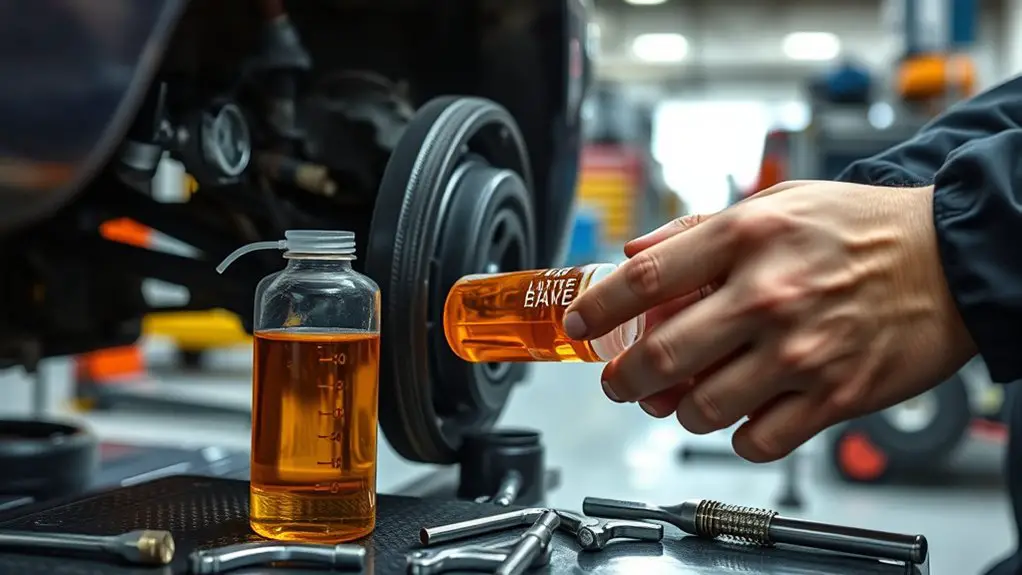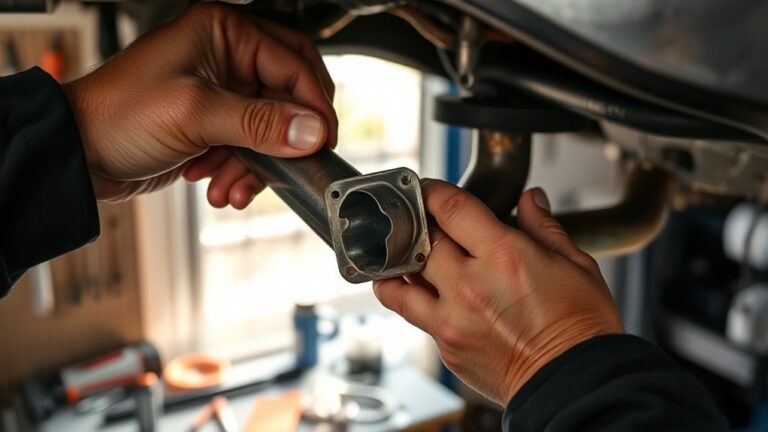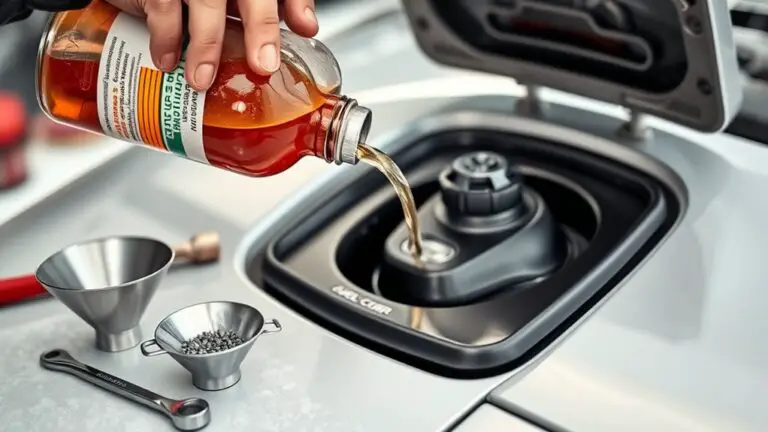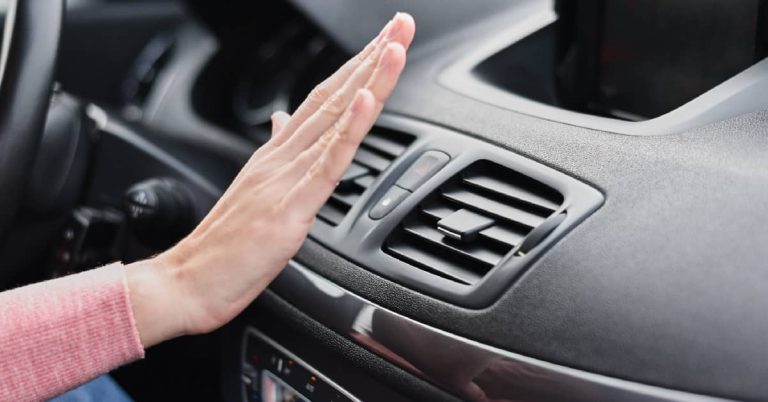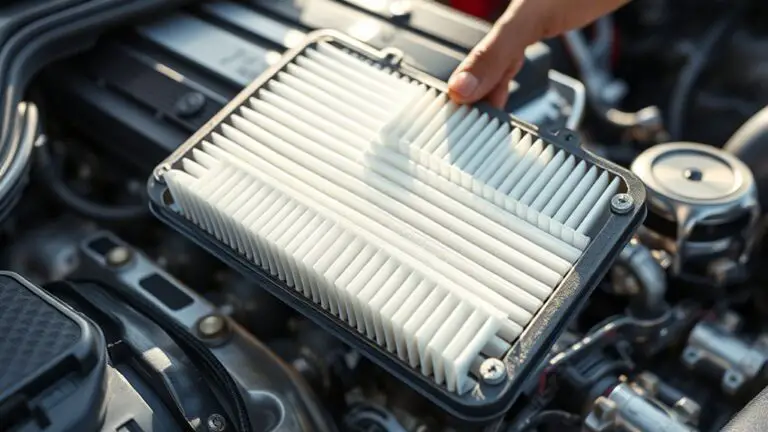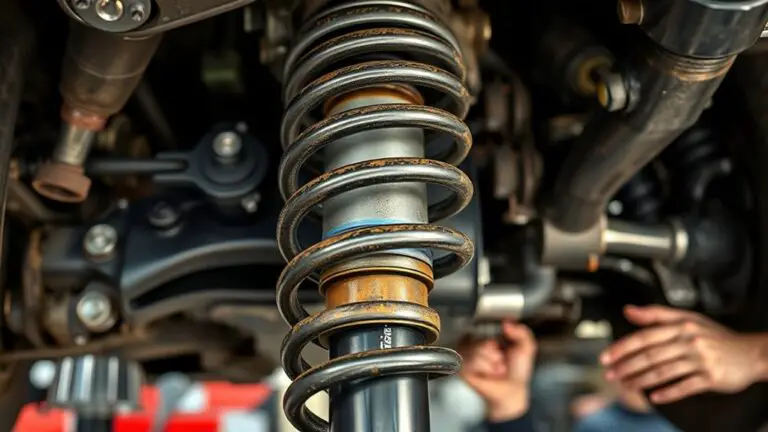Top Causes of Low Brake Fluid and How Mechanics Fix Them
Low brake fluid can seriously compromise your vehicle’s safety. The top causes include brake fluid leaks, worn brake pads, faulty calipers, damaged brake lines, and issues with the master cylinder. Mechanics address these by conducting thorough inspections and necessary repairs, such as replacing worn components or fixing leaks. Regular maintenance is key to preventing problems. Understanding these causes helps you recognize when to seek professional help, ensuring your brakes maintain peak performance for safer driving experiences.
Brake Fluid Leaks
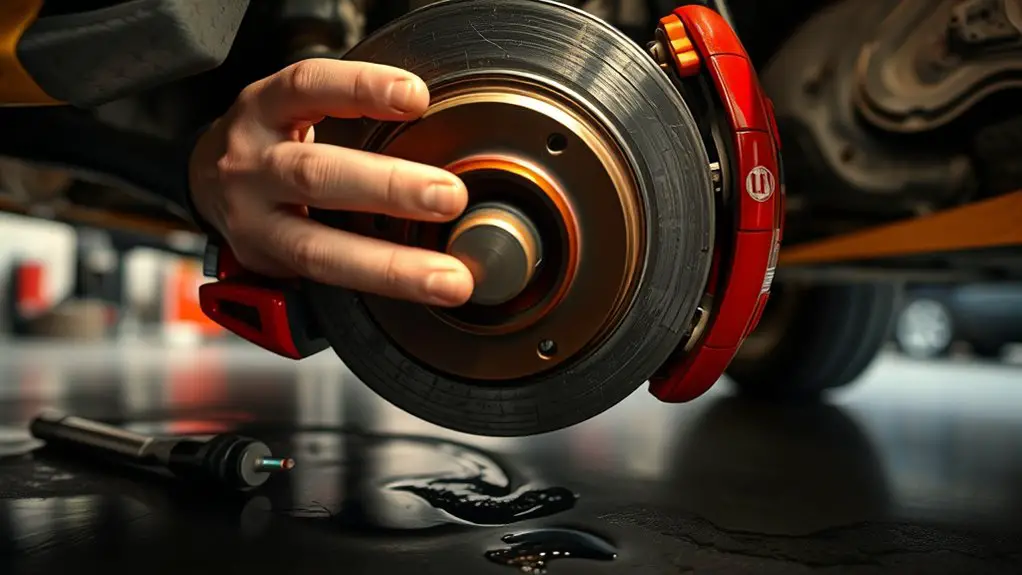
One of the primary causes of low brake fluid is brake fluid leaks, which can greatly compromise your vehicle’s braking performance. When leaks occur, even a small amount of fluid loss can result in reduced brake efficiency, leading to dangerous situations. It’s essential to prioritize brake fluid maintenance to guarantee your system operates smoothly. Regular checks can help you catch leaks early, preventing major issues down the line.
To effectively manage leak detection, inspect brake lines, hoses, and connections for signs of wear or damage. Look for fluid puddles beneath your vehicle and monitor your brake fluid reservoir levels frequently. If you notice a drop, it’s important to address it immediately. Delaying repairs can lead to more severe damage and compromise your freedom on the road. Remember, maintaining your brake system isn’t just about safety; it’s about making sure you can drive confidently wherever your journey takes you.
Worn Brake Pads
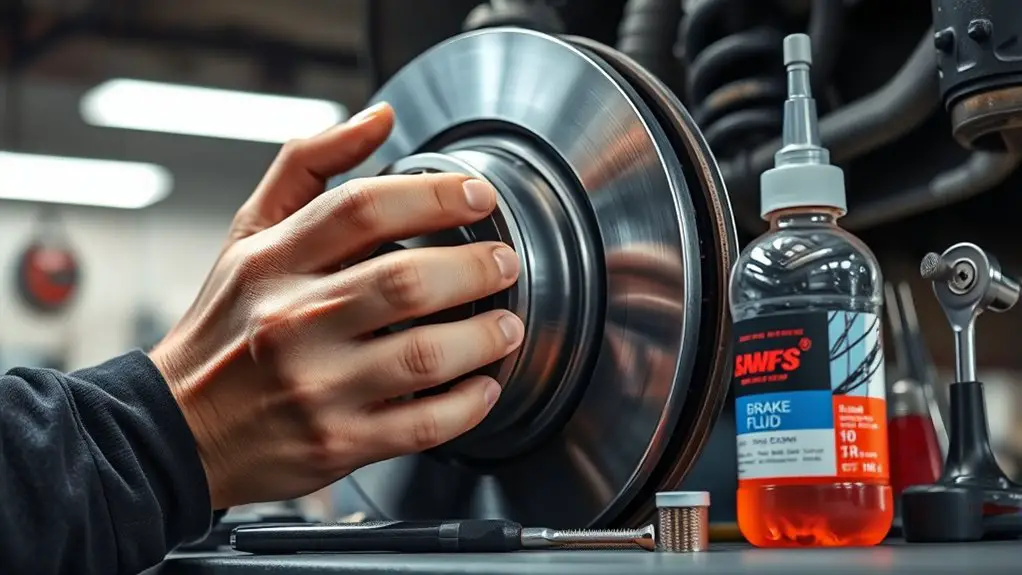
Worn brake pads can considerably affect your vehicle’s braking system, leading to low brake fluid levels. As you drive, the friction generated between the brake pads and rotors causes brake pad wear. When pads become excessively worn, they can create a larger gap between the caliper and rotor. This increased distance requires more brake fluid to maintain effective brake performance, ultimately lowering fluid levels.
Additionally, worn pads often lead to overheating, which can damage other components of the braking system and further exacerbate brake fluid loss. If you notice squeaking or grinding noises, it’s essential to inspect your brake pads immediately. Replacing them promptly not only restores braking efficiency but also prevents more significant issues down the line. Mechanics will typically perform a visual inspection and may recommend replacing both pads and rotors to guarantee peak braking performance and fluid stability.
Faulty Brake Calipers

Faulty brake calipers can lead to significant issues, including uneven brake wear and reduced stopping power. You should be alert for signs of caliper failure, such as unusual noises or pulling to one side while braking. If you experience these symptoms, timely repair or replacement is essential to maintain peak brake function and guarantee your safety on the road.
Signs of Caliper Failure
Since the brake calipers play a crucial role in the vehicle’s braking system, noticing signs of their failure is essential for maintaining safety on the road. One key indicator is uneven brake wear; if you spot uneven wear on your brake pads, it may suggest caliper malfunction. Additionally, listen for unusual noises, such as grinding or squeaking, which can signal caliper issues. A pulsating brake pedal during braking could also indicate a caliper problem. Furthermore, check for brake fluid leaks around the calipers; this can lead to low fluid levels. Regular caliper inspection and proper caliper maintenance can help you catch these signs early, ensuring your vehicle remains safe and responsive on the open road.
Repair and Replacement Solutions
If you’ve identified signs of caliper failure, addressing the issue promptly is essential to guarantee your vehicle’s braking system works effectively. Start by checking your brake fluid levels; low fluid often indicates a caliper leak. If the caliper is damaged, replacement is the most reliable solution. Make sure you choose high-quality calipers designed for your vehicle’s make and model. During replacement, flush the brake fluid system to eliminate contaminants and air. After installation, bleed the brakes to restore pressure. Regular maintenance tips, like inspecting calipers and fluid levels, can help prevent future issues. Remember, a well-functioning brake system is critical for your safety and freedom on the road. Don’t compromise; act swiftly when you notice any signs of failure.
Damaged Brake Lines
If you’ve noticed a spongy brake pedal or fluid leaks near the wheels, your brake lines might be compromised. Signs of damage include visible corrosion, cracks, or bulges in the lines. Repairing damaged brake lines typically involves replacing the affected sections and properly bleeding the brake system to guarantee peak performance.
Signs of Damage
Damaged brake lines are a critical issue that can lead to low brake fluid levels and compromised braking performance. During a visual inspection, you might notice signs like corrosion, cracks, or leaks along the brake lines. These defects often result from wear and tear or environmental factors. If you’re experiencing a spongy brake pedal or a sudden drop in brake fluid, it’s crucial to perform a fluid analysis. This can help identify contamination or moisture in the fluid, which may indicate line damage. Ignoring these signs can result in brake failure, jeopardizing your freedom on the road. Staying vigilant about your brake lines guarantees your vehicle remains reliable and safe, allowing you to drive with confidence.
Repair Techniques Explained
Addressing damaged brake lines requires a methodical approach to verify both safety and functionality. Start by inspecting the lines for leaks, corrosion, or wear. If you find damage, you’ll need to cut away the compromised section. Use appropriate repair techniques, such as flaring the ends of the remaining brake lines and connecting them with a union fitting for a strong bond. Confirm you’re using the correct materials compatible with your brake system to prevent further issues. After repairing, follow fluid replacement techniques to refill your brake system with fresh brake fluid, ensuring you bleed the system to remove any air. Regular brake system maintenance is essential to keep your vehicle safe and responsive on the road.
Brake Master Cylinder Issues
One major factor contributing to low brake fluid levels is issues with the brake master cylinder. This component is essential for your vehicle’s hydraulic system, as it generates the pressure needed to activate the brakes. If there’s a leak or internal failure, fluid can escape, leading to decreased braking efficiency.
Here’s a quick overview of common master cylinder issues:
| Issue | Description |
|---|---|
| Leaking Seals | Worn seals can cause fluid to seep out. |
| Corrosion | Rust and corrosion can damage internal parts. |
| Air in the System | Air bubbles can hinder hydraulic pressure. |
| Blockages | Dirt or debris can obstruct fluid flow. |
To guarantee peak performance, regular master cylinder maintenance is essential. By staying proactive, you can maintain the integrity of your braking system and enjoy the freedom of safe driving.
Contaminated Brake Fluid
While you may not realize it, contaminated brake fluid can considerably impact your vehicle’s braking performance. Brake fluid contamination typically arises from moisture absorption, leading to reduced boiling points and potential brake failure. Here’s what you should know:
- Moisture accumulation: Water can enter the brake fluid, lowering its effectiveness.
- Corrosion: Contaminated fluid can corrode metal components in your braking system.
- Air bubbles: Moisture can create air pockets, diminishing braking force.
- Decreased boiling point: Contaminated fluid can boil at lower temperatures, causing vapor lock.
- Fluid change recommendation: Regularly replace brake fluid to maintain performance and safety.
To guarantee your freedom on the road, always monitor your brake fluid’s clarity and quality. If you suspect contamination, consult a mechanic to inspect and replace the fluid, safeguarding your vehicle’s braking system. Remember, a small oversight can lead to significant consequences.
Frequently Asked Questions
How Can I Check My Brake Fluid Level at Home?
To check your brake fluid level at home, locate the fluid reservoir, usually near the back of the engine bay. Clean the area around the cap to prevent contamination, then remove it carefully. Inspect the fluid level against the markings on the reservoir; it should be between the “MIN” and “MAX” lines. If it’s low, it’s essential to top it off with the appropriate brake fluid type to guarantee safe braking performance.
What Are the Symptoms of Low Brake Fluid?
If you’re experiencing low brake fluid, you might notice a few warning signs. A staggering 30% of drivers report a spongy brake pedal, which indicates insufficient fluid. You may also see the brake warning light illuminate on your dashboard, or hear grinding sounds when you press the pedal. Additionally, if your car pulls to one side while braking, it’s a serious symptom. Don’t ignore these signs; they could indicate a dangerous situation.
How Often Should I Change My Brake Fluid?
You should change your brake fluid every 2 to 3 years as part of regular brake fluid maintenance. However, it’s essential to follow your vehicle’s fluid replacement schedule, as some manufacturers may recommend more frequent changes. Over time, brake fluid can absorb moisture, leading to decreased performance and potential safety issues. Regular checks and timely replacements can guarantee your braking system operates effectively, giving you the freedom to drive confidently.
Can Low Brake Fluid Affect My Car’s Performance?
Yes, low brake fluid can greatly affect your car’s performance. When the fluid level drops, it often indicates fluid leakage, which compromises brake performance. Insufficient fluid can lead to a spongy brake pedal, reduced stopping power, and increased stopping distance. This decrease in responsiveness can jeopardize your safety on the road. To maintain ideal brake function, it’s essential to regularly check and maintain your brake fluid levels.
Is It Safe to Drive With Low Brake Fluid?
No, it isn’t safe to drive with low brake fluid. In fact, studies show that nearly 30% of brake-related accidents stem from insufficient brake fluid, highlighting significant safety concerns. When brake fluid levels drop, you risk reduced braking power and longer stopping distances, jeopardizing your freedom on the road. Prioritize your safety by checking fluid levels regularly and addressing any leaks or issues immediately to guarantee your vehicle performs at its best.

